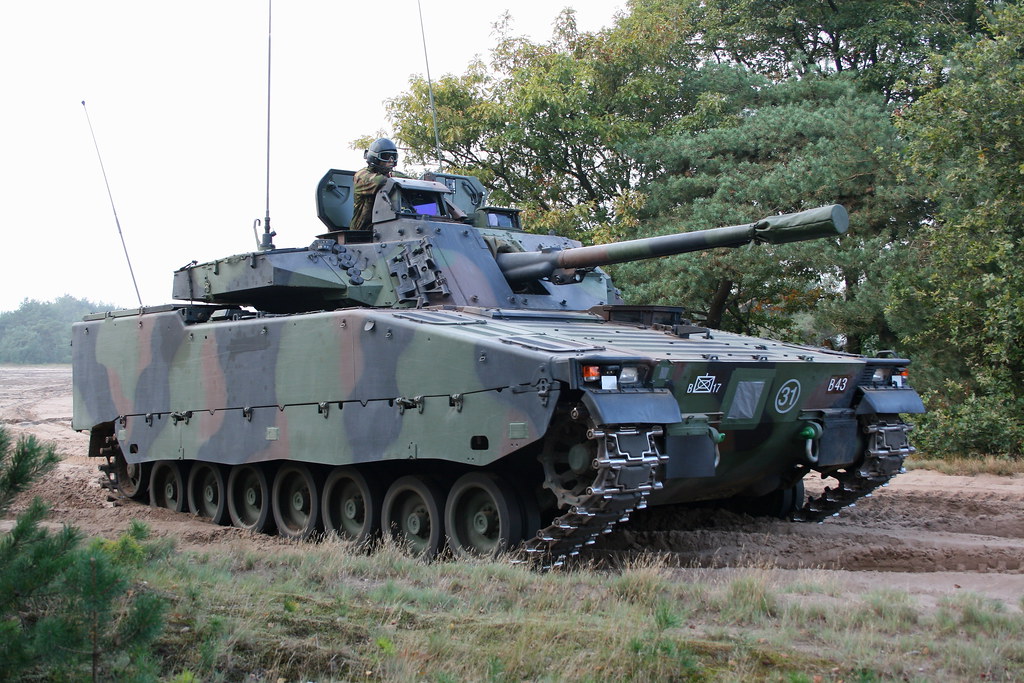Part of the phase 3 is the procurement of a planned 450 medium-weight tracked vehicles, of which 312 will be fitted with a turret in an infantry fighting vehicle (IFV) configuration.
As of today, three contenders for this contract are known: The German company PSM (a joint venture of Rheinmetall and KMW) will offer their Puma IFV, BAE Systems is reportedly offering the CV9035 and General Dynamics is supposedly offering a vehicle based on the ASCOD 2.
The Puma is one of the latest IFVs, with the first Puma entering service in June 2015. It's probably the heaviest armored IFV available on the market and is fitted with a number of advanced features like a decoupled running gear with hydropneumatic suspension, third generation thermals, a softkill active protection system (APS) and a modern fire control system (FCS) with independent commander's sight. The Puma will be armed with a 30 mm MK-30/2 ABM autocannon with athe ability to fire airburst ammunition, a coaxial machine gun, a dual-purpose Spike-LR ATGM launcher and an independent grenade launcher mounted on an elevatable mast. The Puma has not been fitted with an remote weapon station (RWS) yet.
It is powered by a 10 cylinders MTU MT892 engine which is fitted in combination with a version of the HSWL 256 transmission from Renk. It provides an output of 800 kW.
| The Puma IFV is the newest vehicle competing for LAND 400 |
Problems for the Puma are at least the lack of a turretless version for the non-IFV version, the rather huge price tag and the lower troop carrying capacity.
| The ASCOD 2 is based on the development of the Ulan (pictured) and Pizarro IFV |
 |
| An ASCOD 2 APC presented on Eurosatory 2014 |
 |
| A CV9035 of the Koninklijke Landmacht |
The CV 90 Mk. III is powered by a Scania V8 engine with an output of 600 kW. The basic vehicle is constructed from steel, providing protection against 14.5 mm AP and 23 mm API along the frontal arc. However like the ASCOD 2, the CV9035 is pretty much always fitted with applique armor to boost the protection level to STANAG 4569 level 4 and/or level 5 at least. Further armor kits and mine-protection kits for the CV9030 and CV9040 have been developed, it seems reasonable to assume that those armor kits can be modified to CV9035 compatability. While BAE's brochures claim that the CV90 has hunter-killer capability, it seems that this is dependent on the exact FCS version fitted, which differs depending on user's configuration.
 |
| The Armadillo APC is a turretless CV90 |
The CV9035 however is also the oldest designs and suffers from more drawbacks. Like the ASCOD 2, the CV9035 lacks an ATGM armament for fighting heavier armored targets and/or helicopters. While the 35 x 228 mm caliber of the Bushmaster III gun packs about 50% more punch than a 30 x 173 mm round of the MK-30, it's much larger physical size has a very negative impact on ammunition stowage. While the Puma and ASCOD 2 (with SP-30 turret) both can carry 200 rounds loaden at the gun, the CV9035 has only 70 rounds available at the gun. The total ammunition stowage is also much lower. Furthermore the CV9035 is also not able to meet the 8-men dismount squad requirement of the Australian Army in it's current configuration deployed by the Dutch and Danish armies.
Lastly the ballistic and mine protection of the CV9035 seems to be relatively low compared to that of the Puma and ASCOD 2. While armor packages are available, these might need additional reconfiguration to the exact CV9035 layout and
It is interesting what currently seems to be happening in the SEA region. Australia is planning to acquire huge numbers of state-of-the-art wheeled and tracked vehicles, while many NATO countries including the US have to cut back most of their military procurment plans due to funding issues. There are a number of issues and unkown factors with the Austrlian LAND 400 program still: We don't know if other contenders will or already have responded to the tender for the tracked vehicle aswell. Currently we only know that the Puma - apparently most likely in the standard German Army configuration - the ASCOD 2 in an unkown configuration and the CV9035 in a somewhat unkown configuration will compete for the contract. All three of the previous mentioned vehicles might have trouble with the Australian Army's requirement for transporting a 8 men squad of dismounts and have other individual issues each. From my point of view the Puma might be the best bet, but also the most expensive. In terms of protection, technology and the armament concept (once the integration of the Spike-LR and the grenade launcher are finished) seems to be the most promising. The lack of ATGM armament on the other vehicles would be a no-go for me, but we don't know what GD and BAE will change for Australia. But who knows what the Aussies want, in the end they happen to have one of the most scatterbrained and odd mechanized infantry concept out there.
The LAND 400 phase 2 will probably already be a preliminary decision, it seems likely that the winner of one contract will have a huge benefit in the other due to the ability of keeping parts exchangeable and cutting costs down.
No comments:
Post a Comment